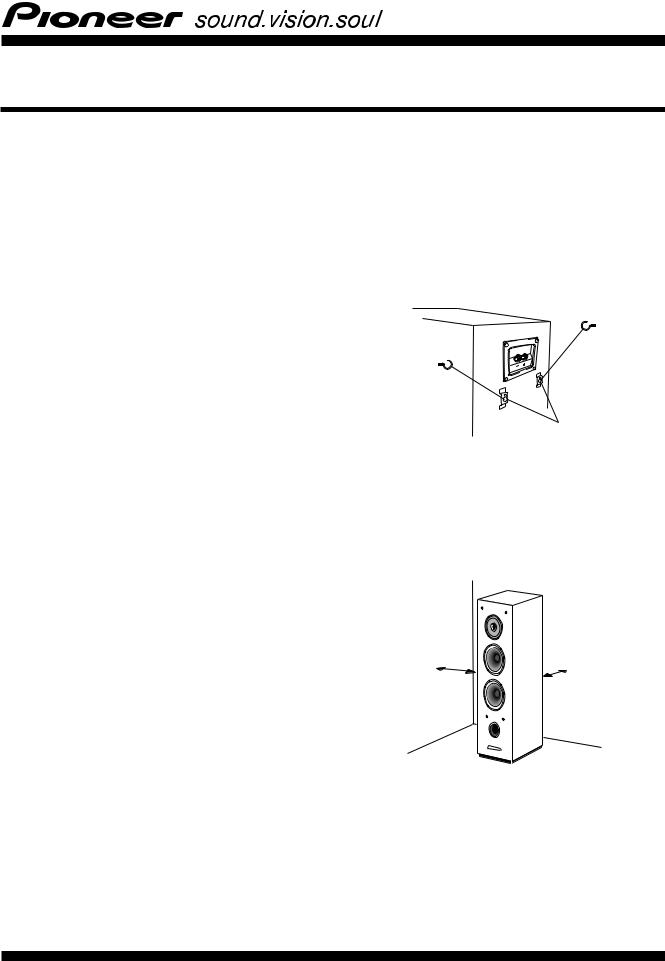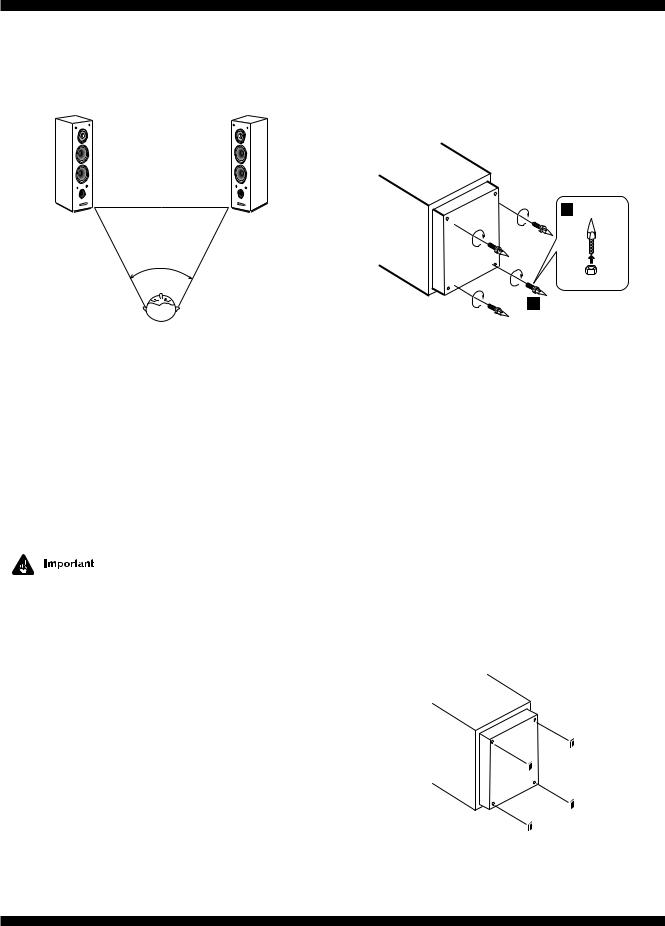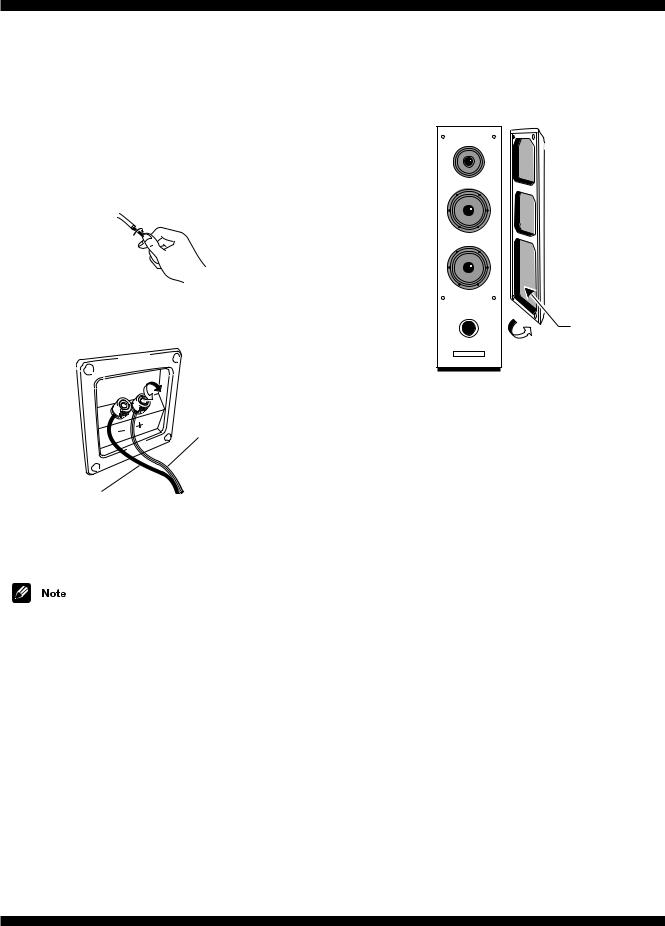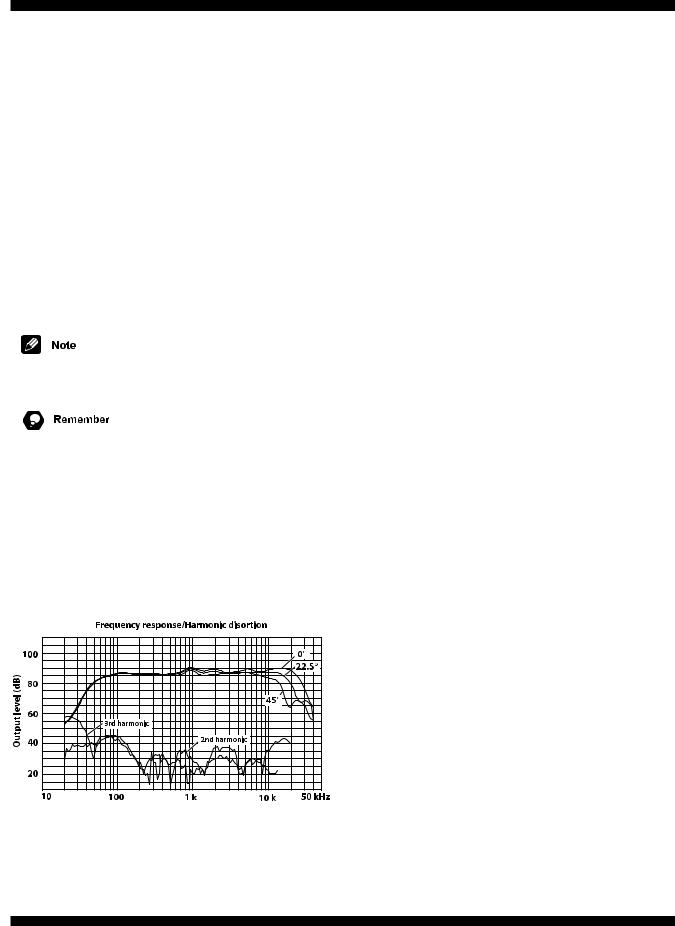Pioneer S-A5 Manual

S-A5 Speaker System
Thank you for buying this Pioneer product. Please read through these operating instructions so you will know how to operate your model properly. After you have finished reading the instructions, put them away in a safe place for future reference.
Before you start
•The nominal impedance of this speaker system is 6 ohms. Connect the speaker system to an amplifier with a load
impedance ranging from 4 to 16 ohms (a model with “4 – 16 Ω” displayed on the speaker output terminals).
•Do not touch the speaker cones as they are easily damaged.
In order to prevent damage to the speaker system resulting from input overload, please observe the following precautions:
•Do not supply power to the speaker system in excess of the maximum permissible input.
•When connecting or disconnecting anything in your AV system, make sure the amplifier is switched off.
•When using a graphic equalizer to emphasize loud sounds in the high-frequency range, do not use excessive amplifier volume.
•Do not try to force a low-powered amplifier to produce loud volumes of sound (the amplifier’s harmonic distortion will be increased, and you may damage the tweeter).
Caution: installation
•Do not place the speaker on an unstable surface. It could present a hazard if it falls, as well as damaging the equipment.
•Switch off and unplug your AV equipment and consult the instructions when connecting up components. Make sure you use the correct connecting cables.
•Do not put a TV or other AV equipment on top of this speaker. It could present a hazard if it falls, as well as damaging the equipment.
Caution: in use
•Don’t use the speaker to output distorted sound for long periods of times. This can result in a fire hazard.
•Do not sit or stand on the speaker, or let children play on the speaker.
•Do not put large or heavy objects on top of the speaker.
Installing your speaker
Please observe the following points when installing speakers:
•Sounds played through speaker systems are easily affected in subtle ways by the conditions in the listening space.
•On the rear of the speaker are two metal catches. These are for stabilizing the speaker so that in the event of an earthquake, etc., the speaker does not fall over.
•Screw two picture hooks or similar into the wall behind the speaker. Pass a chain or cord around the hooks and through the metal catches so that the speaker is stabilized.
metal catches
• After installing, make sure the speaker is securely fixed.
Pioneer cannot take responsibility for injuries or accidents arising from improper installation of this speaker.
•Speakers are heavy, so make sure the surface where you install them is solid. For good sound, the speaker should be about 20cm away from the back wall and at least 50cm away from the side wall.
50cm |
20cm |
1

•Place speakers equal distances from your listening position for good stereo sound. Use speaker cords of the same length for each speaker.
50 – 60º
Attaching the spikes
A set of four metal spikes is supplied that you can use to isolate the speaker from the floor. We recommend using the spikes over the supplied non-slip pads as they will improve the sound of the speaker.
1 Spike
Speaker base 
Nut
2
•If you’re using these speakers for your TV sound, install them at equal distances either side of the TV and point them in the same direction as the TV.
•If the room has a lot of reverberation, we recommend hanging heavy fabric on the walls, and/or putting a carpet on the floor to damp the sound. For best results, cover walls completely.
•Do not place the speaker where it will be in direct sunlight, and avoid positioning it near heaters and air conditioners. This may cause warping and discoloration of the speaker cabinet and damage the speakers.
•The speaker is heavy. Placing it on an unstable surface is dangerous, and should be avoided.
Pioneer assumes no liability whatsoever for damages resulting from assembly, improper mounting, insufficient reinforcement, misuse of the product, acts of nature, etc.
For each spike:
1Screw the nut all the way onto the spike.
2Screw the spike into the base of the speaker.
There are four holes for the spikes in the base of the speaker cabinet.
3Place the speaker upright so that the spikes are resting on the spike bases on the floor.
4Adjust the spike lengths by unscrewing them slightly from the speaker cabinet.
Adjust so that the speaker is resting squarely on all four spikes.
5Tighten the nut up against the base of the speaker.
Attaching the non-slip pads
A set of four self-adhesive non-slip pads are supplied that you can use in place of the spikes to provide some isloation and also prevent the speakers moving.
1 Remove the backing tape of the non-slip pads and stick one in each corner on the base of the speaker.
Speaker base 
2

Connecting to an amplifier
Before connecting to your amplifier, make sure that the amp is switched off.
Use the supplied speaker cable to connect up the speakers. Make sure that you match up the speaker terminals on the speakers with those on your amplifier so that the positive (+) terminals and negative (–) terminals are paired.
1 Twist off the protective shielding on the ends of the speaker cable. Twist together any stray strands of speaker wire.
2 Unscrew the terminals on the speakers and insert the speaker wire as shown.
Striped half of speaker cable to positive (+) speaker terminal
Other half of speaker cable to negative (–) speaker terminal
3 Connect the other end of the speaker cable to the speaker terminals on your amplifier.
You can also use banana plugs to connect up the speaker.
•After connecting the plugs, pull lightly on the cables to make sure that the ends of the cables are securely connected to the terminals. Poor connections can create noise and interruptions in the sound.
•If the cables' wires happen to be pushed out of the terminals, allowing the wires to come into contact with each other, it places an excessive additional load on the amp. This may cause the amp to stop functioning, and may even damage the amp.
Detatching and replacing the front grille
The front grille of this speaker system is removable. Proceed as follows:
Note which way up the grille goes
1Use both hands to hold the bottom part of the grille, and pull it gently towards you. You will then be able to free the bottom part of grille.
2Similarly, take hold of the top part of the grille, and pull it towards you; the whole grille will then be detached from the speaker system.
3To replace the grille, align the holes in the grille’s corners with the projections on the front of the speaker, and push each of the corners into place.
Magnetic shielding
This speaker system is magnetically shielded. However, depending on the installation location, color distortion may occur if the speaker system is installed extremely close to the screen off a television set.
If this happens, turn off the television, then turn it on again after 15 to 30 minutes. If the problem persists, place the speaker system away from the television set.
Cleaning the speaker cabinet
With normal use, wiping with a dry cloth should be sufficient to keep the cabinet clean. If necessary, clean with a cloth dipped in a neutral cleanser diluted five or six times with water, and wrung out well. Do not use furniture wax or cleansers.
Never use thinners, benzine, insecticide sprays or other chemicals on or near this unit since these will corrode the surfaces.
3

Specifications
Enclosure ........................... |
Bass-reflex type magnetically shielded |
|
floorstanding speaker |
Configuration ............................................................................. |
2-way |
Woofer .................................................................. |
13 cm cone x2 |
Tweeter .................................................................... |
2.5 cm dome |
Nominal impedance .................................................................... |
6 Ω |
Frequency response .................................................... |
31~42,000 Hz |
Sensitivity ................................................................ |
88 dB/W (at 1 m) |
Allowable input |
|
Maximum input (EIAJ) ...................................................... |
100 W |
Crossover frequency .............................................................. |
2.5 kHz |
Exterior dimensions (mm) ............. |
175 (W) x 895 (H) x 280 (D) mm |
Weight ..................................................................................... |
17.2 kg |
Supplied accessories |
|
Speaker cable (2.5 m) .............................................................. |
x1 |
Spikes ........................................................................................ |
x4 |
Spike bases ............................................................................... |
x4 |
Non-slip pads ...................................................................... |
x1 set |
Operating instructions ............................................................. |
x1 |
Specifications and design subject to possible modification without notice, due to improvements.
Real, natural wood is used in the construction of the speaker system cabinets. They feature a wonderful color and depth that is much more attractive than plastic veneers and similar materials.
No two pieces of natural wood are exactly alike. Keep this point in mind as you enjoy these speakers.
Frequency response and harmonic distortion
Published by Pioneer Corporation.
Copyright © 2002 Pioneer Corporation.
All rights reserved.
4
